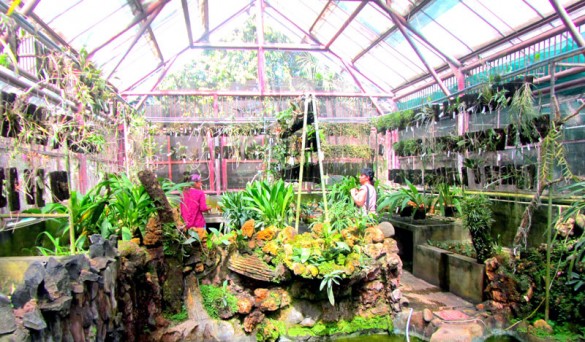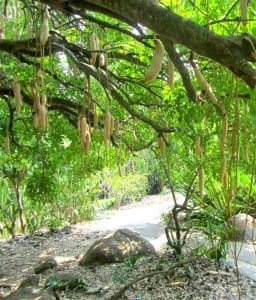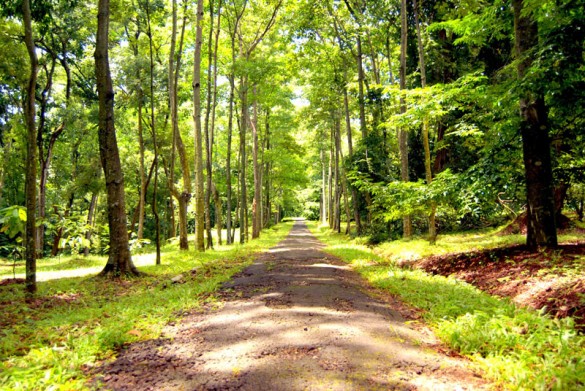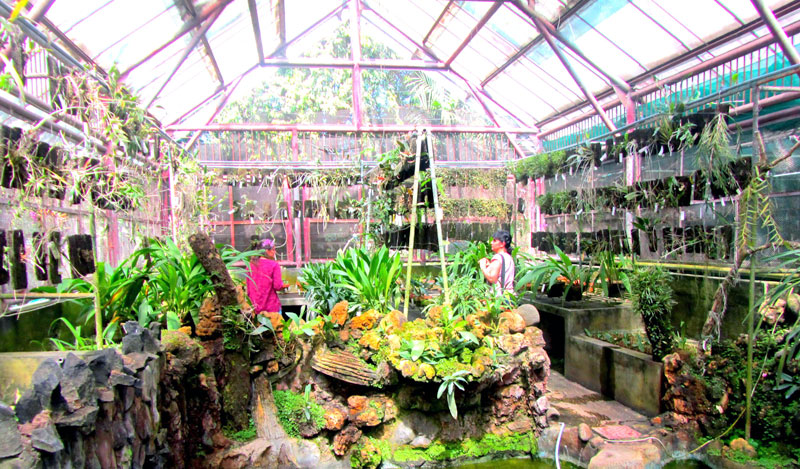
The hustle and bustle of Surabaya is all very well when you have something important to do in the city centre. But when you need a break from the hectic – a place for a stroll or a leisurely picnic – it doesn’t cut much ice. Purwodadi Botanical Gardens, a 90-minute drive 70 kilometres south of Surabaya towards Malang, is the perfect spot to regain some equilibrium.
A branch of the famed Bogor Botanical Gardens in West Java, they were established in 1939 during the Dutch colonial period to catalogue and research flora requiring a relatively dry, lowland climate. However, with an altitude of 300 metres above sea level, the heat of Surabaya has largely gone. Well over 3,000 species are represented on this 85-ha site. The visitor will be amazed at the extraordinary diversity of plant life represented here and be grateful for the chance to see several species that are becoming rare or endangered.
Walking through the ornamental entrance gates based on the design of the 14th century Penataran temple near Blitar, a long avenue stretches away from you as far as the eye can see with Mount Baung just visible in the far distance. Enormously tall Jacaranda (Jacaranda obtsifolia) and Golden Shower (Cassia fistula) trees line the central path that divides the gardens into two halves.
If you venture off to the right you will come to an area of palms offering a tremendous array of species. Palm trees are not only ornamental, but provide many useful food sources such as oil and fruit. The Sugar Palm (Arenga pinnata), of which we can see some impressive specimens, comes in handy as not only a source of sugar, but also for its black fibre, used for thatching and in the manufacture of brooms and rope.
Not a palm, but seen growing in this section, is the amazing Amorphophallus titanum, one of the largest flowers in the world and with its phallic shape and overwhelming smell, it is quite a curiosity. It only flowers once every three or four years, but the flower can reach two metres in height and 40 centimetres across.
Not far from the main gate stands the biggest tree in the gardens with a trunk width of nearly three metres. The Giant Sengon (Enterolobium cyclocarpum) drapes its enormous canopy over many quite substantial trees growing beneath. Black pods from the Sengon are scattered on the ground. I am told that these are edible when fried, although it is hard to imagine so from the look of them.
Five pretty ponds nearby offer an interesting array of aquatic plants. Water lilies with bright red flowers provide a home on the water to the myriad frogs that live here. The ponds are surrounded by well kept lawns and most of the visitors find this the prettiest spot to sit and relax. A number of gazebos are situated throughout the park, providing somewhere to shelter from the sun.
A collection of ferns next to the ponds shows us how many different species are found in Indonesia. Many of these, like the palm trees, are a food source or are used in weaving or for ornamental purposes.
One plant type which we particularly associate with Indonesia is the bamboo, but few visitors would have realized that there are so many varieties, all grouped together here for comparison. There are so many differing widths, strengths and colours. Here, too, is the Pringwuluh bamboo (Schizostachyum blumii) from which the traditional Javanese flute – the seruling – is made.
Just behind the main office, with its library, seed collection and plant nursery, a series of glasshouses feature a splendid orchid collection. The director of the Gardens tells me that there are 525 species here; many of them rare and seldom seen outside Indonesia. Among these is the Moth Orchid (Phalaenopsis amabilis), known here as Puspa Pesona – the floral emblem of Indonesia and traditionally used in wedding bouquets.
A visit to these beautiful grounds would not be complete without taking in the mango and banana collections – the two ubiquitous fruits of Indonesia. A stunning array of 150 varieties of banana from Java and other islands east of here can be seen to the left of the main avenue, many of which are quite unlike the common varieties we see in the market.
If you have time, there is a collection of cacti worth seeing not all of which are prickly and menacing. Some are surprisingly pretty when in flower.
Behind the Gardens rises Mount Baung. This actually lies outside the property’s perimeters, but as part of a nature reserve it offers further opportunity to witness the natural scenery of East Java. Either by taking a rather decrepit suspension footbridge east out of the Gardens or by driving along a dirt road just north of the main gates, you can see the dramatic Coban Baung waterfall. Nature has been kind to the visitor; its magnificent fall can be viewed from a safe and easy distance – opposite. Or for the more courageous, a slippery climb down the hillside will take you beneath the falls where local children shower and fish the stream.
Purwodadi Botanical Gardens
Jalan Raya Purwodadi
Purwodadi
Pasuruan
Open every day from 7am to 4pm
Tel: +62 (0341) 6150336
Province: East Java
Elevation: 300 metres
How to get there: It is best reached from Surabaya. Garuda Indonesia, Citilink, Air Asia, Lion Air all fly into Surabaya. From the airport a car can be rented to take you to Purwodadi Botanical Gardens (90 minutes) and on to Malang (30 minutes).
Where to stay: Malang is nearest; the finest accommodation is Hotel Tugu. This luxurious hotel has won many awards for its Asian ambience and outstanding decor.
What to bring: Walking shoes, hat, sunscreen, camera, entrance fee of Rp.6,000.




